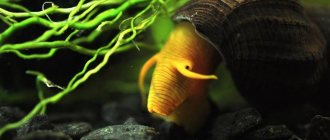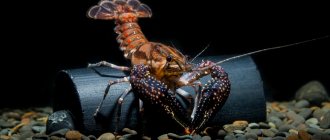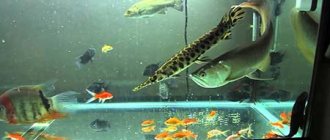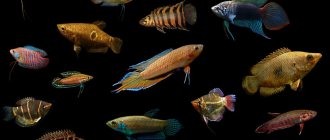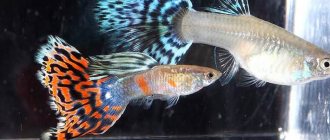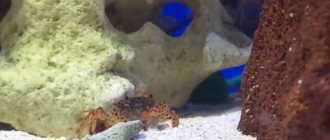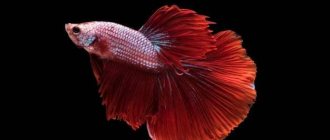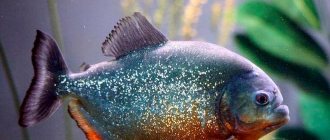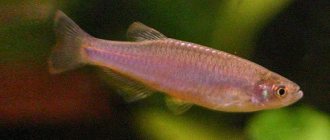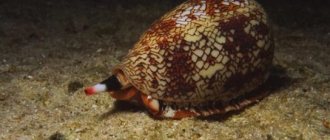Catfish is an amazing fish, which, depending on the species, can weigh up to 200 kilograms, and some aquarium specimens do not exceed two centimeters in length. The uniqueness of pets lies in their resistance to external conditions, which allows them to feel comfortable in the wild, both in swamps and fast-water rivers. When placed in an aquarium, catfish become real orderlies, eating all the garbage and leftover food from other fish. Let's look at the features of keeping these pets at home and figure out what to feed aquarium catfish.
Description and habitat
Catfish belong to the catfish family, and in their natural environment inhabit fresh water bodies throughout the planet. Catfish are rare in the seas. Most representatives of these fish prefer to live in the lower layers of the water column and are also nocturnal.
The size of aquarium catfish varies depending on the variety: both dwarf individuals and large catfish are found. In addition, catfish fish can be peaceful or aggressive, vegetarian or predatory, and even poisonous. A distinctive feature of all representatives is the absence of scales, although some species have bone plates or a shell instead.
Nowadays, the most popular in aquarium hobby are chain-linked catfish, although previously small armored catfish were considered favorites. The lifespan of aquarium catfish is 5-10 years; some species can survive safely in captivity for up to 15 years. Beginning aquarists who decide to buy these unpretentious and cute pets should remember that catfish do not eat garbage and other waste. They, like any other living beings, need care and proper nutrition.
Character and behavior
Catfish can adapt to a wide variety of conditions. They are hardy, unpretentious, and able to repel the attack of large fish. They themselves are calm and non-aggressive. Many species of catfish are ideal for life in an aquarium.
Among catfish there are both predators and species that prefer to feed on small invertebrates, algae, and detritus. In an aquarium, catfish are usually found in the lower layers, eating food that has sunk to the bottom. Because of this feature, catfish are called orderlies or aquarium cleaners.
Features of the behavior and character of catfish:
- prefer not to stray far from their hole;
- love to live and hunt alone;
- are active at night or closer to dawn;
- young fish feed mainly in shallow water, not far from the shore;
- the day is spent in the den;
- in warm weather they can get out of holes and slowly ply in the water, enjoying the warmth and sun;
- prefer to live in clean water;
- react to strong odors.
The fry stay in schools. The same can be said about young catfish. If there is enough food, fish can stay in groups for up to 3-4 years. Then they begin to live alone, each individual has its own feeding territory and defends it.
Types of aquarium catfish
The catfish family is divided into many species, but only a few varieties are very popular among aquarists. Fans of the underwater world are especially fond of chain-linked catfish, which stand out among their relatives due to their bony plates. Before choosing one or another variety, you should familiarize yourself with the descriptions and preferences of different types of aquarium catfish:
- Pimelodidae - in their natural habitat they inhabit fresh rivers, therefore, when keeping these catfish in captivity, a clean and oxygenated aquatic environment is required. Pimelodaceae representatives do not have suckers, as a result of which aquarium fish lead an active lifestyle. The sizes of pimelod catfish vary from tiny - 5 cm, to giant - 60 cm.
- Agamix catfish are friendly and peace-loving creatures that grow up to 10 cm in length. Agamiks are nocturnal, so they are active in the aquarium at night, spending the day in shelters. They love to dig into the mud, raising turbidity and dust from the bottom, so it is best to keep agamixes in a tank with coarse soil.
- Pterygoplichts - these charming catfish for the aquarium are considered orderlies of the underwater world, and are able to get along well with other relatives. They feed on plant foods, and when there is a shortage of them, they switch to algae. When kept at home, pterygoplicht catfish require planting a large number of plants.
- Aquarium ancistrus - these catfish are also called stickers. Ancistrus grow more than 10 cm in length and prefer to feast on plant foods. The body of the fish is covered with bony plates, the color is gray or brown with black or light markings.
- Corydoras panda - inhabitants for a small aquarium. Among the species, speckled catfish and panda corydoras are especially popular. Representatives are distinguished by their peaceful nature - the Corydoras has excellent compatibility with the Kharacinovs and many other aquarium inhabitants. The color of the Corydoras is grayish-olive with dark markings, the abdomen is painted in a light shade.
- Loricaria - these unpretentious catfish belong to the armored catfish. Loricaria grow up to 12 cm in length, and the differences between males and females are clearly visible: males are slimmer and have a fleecy brush on their chest.
Features of the feeding behavior of the species
Fish of large breeds in their natural habitat, going out to fish, can easily grab a duck sitting on the water or a pigeon that has come too close to the reservoir. Catfish have an amazing reaction; they very sharply and accurately rush at the prey, sucking it into themselves, grabbing it with their teeth and dragging it to the bottom. For this reason, this breed of fish has gray, brown and beige colors, which allows them to camouflage themselves by blending into the substrate.
There are many varieties of catfish that can be bred and raised as aquarium fish. There are about 1,200 species of decorative breeds alone. The most frequently purchased are ancistrus (catfish stickers), belonging to the chainmail or loricariid family. Other breeds are also kept at home:
- corridor speckled;
- mumbling catfish;
- plecostomus;
- brocade pterygoplicht;
- mystus striped;
- callicht;
- otocinclus, etc.
All representatives of the order have similar external characteristics and have similar feeding behavior. They mostly feed on waste left over from other fish - pieces of shrimp, shellfish and fish that lie at the bottom of the reservoir. In some cases, catfish attack small waterfowl, as they are excellent hunters.
In order for the inhabitant of the aquarium bottom to eat well, you should remember its specific biorhythm. During the daytime, the hunter rests, and at night, when everything is quiet, he goes out in search of food. Therefore, it is best to feed the catfish at night, turning on special lighting for it. This will avoid situations where other fish eat all the food, and the ancistrus is left without food.
Considering all the positive aspects of keeping stickies, you need to remember that they are aquarium orderlies. That is why they are most often placed with other fish. The omnivorous pet has suction cups, with the help of which the Ancistrus catfish cleans the walls of the water tank, removing food residues (this can be clearly seen in the video of fish feeding). Thus, to create comfortable conditions, tablets or other food can be applied to the walls of the aquarium under the internal filter. They need to be glued, as it were, so that in the future the hunter can assemble everything on his own.
Features of keeping catfish in an aquarium
The aquarium catfish is an unpretentious pet, whose maintenance will not cause difficulties even for a novice aquarist. First of all, in order for the fish to develop normally and grow to the required size, it is necessary to purchase a spacious reservoir, otherwise small catfish will grow in the aquarium. The bottom of the container should be wide, since catfish spend most of their lives at the bottom.
The size of the aquarium depends on the chosen species - if you plan to buy small catfish, then a volume of 50-100 liters will be sufficient. For large catfish, the minimum dimensions of the reservoir are 300 liters. Water parameters for keeping catfish:
- Temperature – 22-28C.
- Acidity – 6-7.5 pH.
- Hardness – up to 10 dH.
Water changes are performed weekly, updating 25% of the volume. Particular attention should be paid to the cleanliness of the aquarium - despite the fact that catfish help maintain order, pets do not eat garbage and waste, so the owner will have to take care of this.
Lighting for an aquarium with catfish is set to moderate - intense light will cause a lot of inconvenience to pets who prefer to lead a solitary nocturnal lifestyle. A large amount of live vegetation and shelters are placed in the tank so that shade-loving catfish can rest peacefully during the day.
Aquarium catfish: maintenance, care, compatibility, feeding, description, photo, video.
Care and maintenance
Keeping and caring for catfish is not a complicated process. are kept in normal aquarium conditions at a temperature of 22-28 ° C. Water hardness 6-12 . Acidity is neutral. If your acidity deviates a little in one direction or another, there is nothing to worry about. But it is very important that the water is not salty. Most species are not fussy about the oxygen regime, since catfish have skin respiration or the ability to breathe atmospheric air.
The breathing process consists of the catfish rising to the surface, taking in air and sinking to the bottom until the air is completely used up. The soil doesn't really matter. To make your catfish comfortable, you need to set up an aquarium for him. Since the catfish is a bottom inhabitant of the aquarium, it is necessary to make some kind of shelter for it.
It can be made from stone, different types of driftwood, it can be artificial houses, castles and plants. As for living plants, you need to look at the specific variety of catfish, since many of them are herbivores and the plant may not live with you for long. But still, if you want to plant plants in an aquarium, and your catfish is a herbivore, then you need to choose large plants with a well-developed root system. It is very important to create a territory for the catfish and place driftwood. Without such shelter, the catfish will not be comfortable and its life will be significantly shortened, and thanks to the snag, the catfish will receive important cellulose for life.
Preparing to buy an aquarium catfish
When deciding to purchase a pet, you should make the necessary preparations. By qualitatively researching the features of your pet’s lifestyle and hobbies, you can guarantee the acquisition of the necessary things.
Additionally, catfish are called “household orderlies” for their love of eating soil. The fish destroy scales and food waste from the bottom of the aquarium, thus maintaining the cleanliness of the reservoir.
High-quality cleaning of the aquarium is carried out by pet catfish, which is why the owner of the reservoir can forget about cleaning the aquarium. However, it doesn’t hurt to purchase a high-quality filter, since the fish get their food in an original way. They lift the settled remains from the surface of the bottom, moving their bodies; after the food begins to float, the catfish eat it.
When organizing repopulation in an aquarium, it is important to pay attention to the already established inhabitants of the reservoir. Not all fish get along with their new neighbors and can eat them. Guppies and neons are a favorite delicacy for catfish, so to avoid lethal consequences, the fish should be separated.
To create optimal conditions for catfish, it is necessary to fill the aquarium with stones or dense vegetation. These fish prefer to stay in shelter until it gets dark. During the daytime, they like to clean the bottom of the aquarium. However, catfish are not easy to see, as they have a special protective coloring and practically blend in with the stones.
Compatibility of catfish
Basically, catfish are peaceful, do not get into fights with other aquarium fish, and sometimes there are conflicts among themselves.
It happens that even a stronger catfish begins to chase the weaker one, and, alas, kills him.
But this is extremely rare. The compatibility of catfish with other fish depends on the type of catfish.
Peace-loving, herbivorous animals need to be matched with non-aggressive neighbors. And for predators - larger fish that can fend for themselves.
Reproduction and breeding
The breeding process for catfish is quite simple, and if you only have fish of this species in your aquarium, you don’t even have to put them in a separate aquarium. Otherwise, for catfish spawning, it is better to allocate a container with clean water with a capacity of 30 to 50 liters. Usually there are 3-4 males per female. It is very desirable that in the place where the spawning takes place there is a lot of algae and soft soil.
If you want to encourage your pets to reproduce, you need to change the water temperature within a few days within 17-25 ° C and aerate the aquarium. Spawning usually occurs early in the morning. When the eggs have already been laid, you can leave natural light or darken it a little. A week after spawning, the female will be ready for a new spawning. The fry develop quite quickly and almost immediately they can be fed with finely chopped bloodworms or “dust”.
Feeding
Feeding catfish is very easy. They eat up the fish food that lies on the bottom, thereby cleaning the bottom of the aquarium. They eat almost everything: pieces of fish, shrimp, tablets, frozen food, cereal, and since most catfish are predators, they can eat small fish in an aquarium, perceiving them as food.
Drawing a conclusion, we can say that catfish in an aquarium are the right fish. Unpretentious and does not require additional care, resistant to various diseases, and, well, very original and beautiful. Having a catfish, your aquarium will always look unique, and you will always be able to rejoice and enjoy the beauty of your pet.
In the following articles you will be able to find the most necessary information about the maintenance of aquarium catfish, the species that interest you, the variety of aquarium catfish, feeding, care, as well as tables of compatibility of catfish with other inhabitants of the aquarium.
"Orphans" of the aquarium
You can often hear from pet store sellers that small and large catfish clean the water in the aquarium and the owner does not have to do this. Catfish, combing the soil at the bottom, actually pick up everything edible, partially cleaning the pollution. By the way, this does not mean that your pet’s nutrition should be left to chance.
It is also important to note that the natural habitat of these fish is silted water. But this also does not mean that you can not clean the aquarium at all and only change the water occasionally. Increased aeration of the water is really not necessary, and clean water and an aquarium are the key to the health of your fish. If you also have other fish, they simply need cleanliness, and the catfish will quickly get used to it and will not experience any inconvenience.
General information about catfish
All types of aquarium catfish, of which there are a huge number in nature, are surprisingly similar in appearance. More than 1,200 thousand different waterfowl variations of this species live in aquariums alone. Otherwise, these fish are called cleaners, because they eat the remains of half-eaten, rotting food lying on the bottom.
And many amateurs purchase such “orderlies” precisely because of their accuracy. You can buy such interesting specimens at any pet store. These aquarium fish, instead of scales, have a lamellar covering consisting of bone tissue. This feature distinguishes them from other waterfowl. Catfish mainly live at the bottom of glass reservoirs and are active only at night. They feed on plant foods, but sometimes they do not hesitate to feast on the leftovers “from the master’s bottom table.”
Catfish are very popular among aquarists, so the demand for them is very high. They buy carapaces because they are: quite peaceful; feel excellent in water at temperatures from 18° +25°C; adapted to hard water; They feel confident with its average acidity with plus/minus deviations in different directions.
Nature has endowed catfish with intestinal respiration. Looking out of the aquarium, they swallow air with their mouths, which is then processed into pure oxygen. If a catfish often lingers near the surface of the water, it means that it is difficult for him to breathe. Aquarium orderlies
CATFISH MOCKED CORRIDORAS CONTENTS BREEDING SPAWNING DESCRIPTION VIDEO PHOTO
ANTISTRUS CARE BREEDING CONTENTS COMPATIBILITY DESCRIPTION
TARACTUM-CONTENTS DESCRIPTION BREEDING COMPATIBILITY PHOTO.
PLATIDORAS CONTENTS DESCRIPTION REPRODUCTION PHOTO COMPATIBILITY
PTERYGOPLYCHTHUS BROCADE CONTENTS REPRODUCTION DESCRIPTION PHOTO COMPATIBILITY
SYNODONTIS CONTENTS, REPRODUCTION, DESCRIPTION, PHOTO, COMPATIBILITY.
GLASS CATFISH CONTENTS DESCRIPTION REPRODUCTION PHOTO COMPATIBILITY.
WHITE-SPOTTED AGAMIXIS CONTENTS REPRODUCTION COMPATIBILITY PHOTO.
CATFISH ANCHOR - HARA JERDONI: CONTENTS, PHOTO, VIDEO, DESCRIPTION.
Sacbranchial catfish: CONTENTS, COMPATIBILITY, PHOTO, DESCRIPTION.
LORICARY: CONTENTS, COMPATIBILITY, BREEDING, PHOTO, DESCRIPTION.
Corridoras arcuatus, Corridoras reticulata, Corridoras SCHULTZ - AQUARIUM CATFISH.
KALLICHTHYS OR AQUARIUM CATFISH KALICHTHIS CONTENTS BREEDING PHOTO.
DIANEMA LONGIBARBIS CONTENTS BREEDING COMPATIBILITY PHOTO DESCRIPTION.
GYRINOHEILUS YELLOW (GOLDEN) ALGAE EATER CONTENTS CULTIVATION PHOTO.
BROCHIS OR GREEN CATFISH CONTENTS REPRODUCTION DESCRIPTION PHOTO.
AMBLIDORAS HANCOCK OR MUMBLING CATFISH AQUARIUM FISH.
AGAMIX CONTENTS REPRODUCTION COMPATIBILITY DESCRIPTION PHOTO.
Nutrition
Feeding catfish is even simpler than keeping them. If your pets live in a tank with other fish, then you don’t have to feed the catfish at all - they will happily pick up leftover food from their neighbors, at the same time cleaning the area. When keeping only catfish fish, you can offer your wards the following products:
- Live and frozen food: bloodworms, tubifex, cyclops, shrimp, etc.
- Catfish tablets and flakes.
- Plant foods: cucumber, spinach, green peas, broccoli, etc.
Before serving, live food must be thoroughly washed, and plant food must be scalded with boiling water. If a predatory catfish lives in the tank, you should remember that small neighbors can become its lunch.
Interesting fact: hungry and predatory catfish living in their natural environment can drag even a dog to the bottom.
Features of feeding in a community aquarium
For a comfortable life for bottom-dwelling fish, it is necessary to properly organize their proximity in a common aquarium with other species. It must be remembered that some representatives of catfish are aggressive predators and can attack smaller inhabitants. If catfish are not the only inhabitants of the aquarium and behave dangerously, it is not necessary to transplant them immediately. It is important to pour several types of food into the water at once: for other fish, and a separate specialized composition specifically for catfish. Representatives live on the bottom, so their food usually sinks exactly where it is most convenient to consume, while food for other fish remains floating on the surface.
It is also necessary to ensure the supply of live food (bloodworms and tubifex worms) - some of the worms, when falling into the water, sink to the ground and bury themselves, and the catfish will like to get them out. Live plants in the aquarium (for example, Anubias) are a source of plant food for fish, so no additional feeding is required. With sufficient attention to the inhabitants of the bottom, conflicts will not arise.
Compatibility
Most representatives of catfish, due to their friendly and peaceful nature, get along well with their relatives and other aquarium fish. Modest and quiet, catfish do not enter into conflicts or start fights, but with the wrong neighbors they can become victims. Introducing predatory fish, for example, astronotus, into the same aquarium together with catfish can lead to the death of the latter. It is also not recommended to place small and weak fish - guppies, neons and others - in a tank with predatory catfish, since pets may consider them food.
Interesting fact: the European catfish can weigh up to 400 kg, and is even capable of attacking people.
Selection and arrangement of an aquarium
Aquarium catfish is an unpretentious fish. To keep it at home you will need a spacious aquarium with a wide bottom. The only important condition is that the water in the container must be replaced on time and there must be a good filtration system.
Volume
You should choose a home pond depending on the size of the aquarium fish that will live in it. If for small species of catfish a container with a volume of 50–200 liters is sufficient, then for larger representatives the minimum tank volume is 300 liters.
Decor
The aquarium should have houses for fish, since without shelter they will be uncomfortable. Usually, to do this, there should be enough driftwood and stones in the aquarium so that the catfish can hide under them during the day and have a good rest before dusk. Since most catfish lead a solitary lifestyle, without good shelter they can suffer greatly.
Water
Aquarium catfish should be kept in clean, filtered, unsalted water, as in nature they prefer fresh water bodies. The liquid temperature should be 22–28 °C. Thanks to cutaneous respiration and the ability to breathe ordinary air, catfish rise to the surface, filling their lungs. This quality makes the fish unpretentious to the oxygen regime.
Lighting
Most catfish living at home choose the dark time of day to stay awake. Therefore, there is no need to additionally supply the aquarium with lighting devices. They are comfortable with dim light, and if it is possible to provide them with constant partial shade, then the fish will be able to swim out during the daytime.
Plants
It is recommended to choose vegetation depending on the type of catfish that will live in the aquarium. For vegetarian fish that eat exclusively plant foods, it is better to organize plantings of artificial algae. Natural ones will be eaten very quickly. Of living plants, only representatives with a good root system, such as cryptocorynes and echinodorus, are suitable.
Priming
Aquarium catfish are not picky when it comes to choosing soil. Some species that like to “comb” the bottom of the container raise clouds of turbidity if it is covered with sand. For them it is better to choose coarse-grained soil. The only exception is gravel, which can damage the fish's abdomen and antennae.
Reproduction
Reproduction of catfish at home requires the construction of a spawning tank - a separate container with a volume of 30-70 liters. Having chosen young and strong representatives, the future parents are placed in a spawning tank, and the temperature of the aquatic environment is gradually lowered to 18C to stimulate spawning. It is important not to forget to install an aerator in the nursery and plant living plants. Shelters, snags and grottoes are placed at the bottom.
Before spawning, the wards are intensively fed. Breeding catfish in captivity is an exciting spectacle that has a certain romance. First, the male fish demonstrates beautiful courtship of the lady of his heart: circling around, delicately touching her with his antennae. Having interested the lady, the catfish invites her to the prepared corner for further reproduction. Spawning of catfish lasts 3-4 hours, and during this time the female lays up to 200 large eggs. After hatching, the parents are returned to the old aquarium, and the temperature of the aquatic environment in the spawning tank is increased to 27-28C.
Conditions of keeping and reproduction
Each type of catfish requires certain conditions of detention. For the most part, they do not require any complex care. Water hardness can range from 6 to 12, and the average temperature should not be higher than 26 degrees .
The best acidity is neutral, but some deviations are possible that will not cause much harm to the fish.
All of the listed conditions are approximate , it all depends on the type of aquarium catfish. For spawning, a separate aquarium is used, in which a female and several males will be placed. It is desirable that its volume be at least 30 liters. In this case, soil does not fit on the bottom; it is better to take a plant (for example, anubias) and press its roots with a stone.
The spawning area must have certain conditions, water temperature within 19–21 degrees, dH no more than 15, pH 6–7 . There must be good aeration so that the aquarium is saturated with oxygen.
For reproduction, you need to choose young individuals so that the offspring are stronger. It is advisable to pre-feed the fish with bloodworms; it has a good effect on milk and caviar.
For the spawning itself, you need to select 1 female and 3–4 males . Catfish prefer to lay eggs in cooler water, so you can lower the temperature to 18 degrees. The lighting should be dim enough; you can cover the aquarium with a cloth.
The entire spawning lasts up to 4 hours, during which time the female lays up to several hundred transparent eggs. As soon as the spawning process is completed, the female and males need to be placed in another aquarium and the temperature raised to 27–28 degrees.
As soon as the fry begin to hatch, you can lower the temperature to 20 degrees. Babies need to be fed 4 times a day with live food. After just a month of proper care, they will grow up to 1 centimeter.
Content
Caring for catfish in an aquarium will not cause much trouble for the owner. An important condition for the survival of these fish is timely feeding. If the reservoir is equipped with shelters, algae grows, and a comfortable temperature and water hardness are ensured, then caring for them is a pleasure.
What to feed catfish
Feeding catfish will also not cause much trouble for the owner. If there are other fish in the aquarium, there is no need to feed the catfish specially. They perfectly feed on the remains of food lying on the bottom, while simultaneously cleaning it, so you don’t have to specially feed them. Pieces of fish, shrimp and flakes sold in pet stores are ideal food for aquarium catfish. In addition, small neighbors in the aquarium can become food for predatory representatives. When choosing such species, you need to remember that catfish can eat small fish.
Catfish eats
How long do catfish live?
The largest representatives living in nature can live up to 100 years, but domestic fish are not so long-lived. Depending on the type of catfish and the conditions of its keeping, the average lifespan of catfish is 8 years, provided that aquarium catfish live in suitable conditions.
